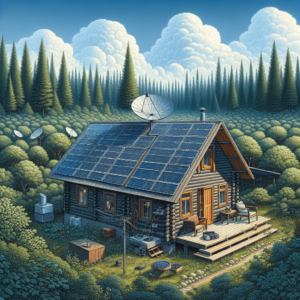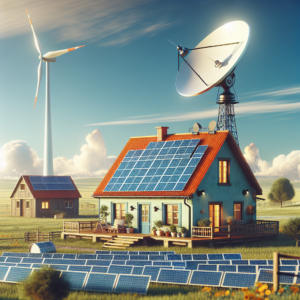
Embarking on the solar energy journey can seem like navigating uncharted waters, but with the right blueprint, you’ll find the course to energy independence is more straightforward than you might think. Whether you’re a seasoned eco-enthusiast or a newcomer to the realm of renewable resources, the goal is clear: maximizing efficiency to benefit both your wallet and the planet.
Key Takeaways
-
Assess your home’s energy efficiency before investing in solar panels.
-
Analyze your solar potential and any limitations, such as shading or roof space.
-
Explore solar options, including rooftop panels or community solar programs.
-
Understand the financial aspects, like incentives and payback periods, of going solar.
-
Connect with local solar providers to get a tailored system for your three-bedroom home.
Getting Started with Solar
First things first, let’s talk about making your home more energy-efficient. It’s like prepping your canvas before you paint; you want the smoothest, cleanest surface to work with. The same goes for your home before adding solar panels. Start by identifying and fixing any energy leaks, such as drafty windows or poor insulation. This step ensures you’re not losing precious heat in the winter or cool air in the summer, which can skew your energy needs and the size of the solar system you might think you need.
Space-Efficient Solar Solutions
Not every home has a sprawling rooftop waiting for a solar array, especially in urban areas where space is at a premium. However, even a three-bedroom home can harness the power of the sun effectively. The key is to optimize the space you have. For example, if your roof can’t accommodate a large number of panels due to its size or orientation, consider higher efficiency panels that can generate more power per square foot.
Besides that, there are innovative options like solar shingles or thin-film solar panels which can be directly integrated into your roof without the need for bulky racks and mounts. These solutions not only save space but also maintain the aesthetic appeal of your home.

Create Your Solar Strategy
Now, let’s dive into creating your personalized solar strategy. It’s not just about slapping some panels on your roof and calling it a day. You need a plan that considers your home’s unique characteristics and your personal energy consumption habits.
Evaluating Your Home’s Solar Potential
To accurately gauge your home’s solar potential, you’ll want to look at several factors. How much sun does your area receive on average? Are there trees or buildings casting shade over your roof? These are critical considerations because they directly impact how much solar power you can generate.
There are tools available that use your address to estimate potential solar production. These resources can be a good starting point, but nothing beats a professional on-site assessment. A local solar provider can offer a more precise analysis, considering factors like roof angle, orientation, and any local regulations that might affect your installation.
Optimizing Your Roof for Solar Panels
Once you’ve determined that your home is a good candidate for solar, it’s time to optimize your roof. If you have a south-facing roof with little to no shade, you’re in prime solar territory. But don’t worry if that’s not the case. East or west-facing roofs can still capture significant sunlight, especially if you adjust the tilt and orientation of the panels for maximum exposure.
It’s also important to consider the condition of your roof. If it’s nearing the end of its lifespan, it might be wise to replace it before installing solar panels. This way, you avoid the extra cost and hassle of having to remove and reinstall the panels when it’s time for a roof replacement.
Stay tuned for the next steps on how to maximize space and efficiency with solar energy for your three-bedroom home. We’ll cover compact solar panel options, innovative technology, and how to extend your solar reach beyond the roof.
Beyond the Roof: Expanding Your Solar Reach
When your rooftop can’t hold all the solar panels you need, it’s time to get creative. The land around your home can be just as valuable for capturing solar energy. Let’s explore how you can utilize ground space and integrate solar power into your outdoor living areas.
Utilizing Ground Space: Solar Gardens and Carports
If your backyard has some unused space, it might be perfect for a solar garden. Solar gardens are ground-mounted solar panels that can be installed in various configurations, depending on your yard’s layout and your family’s needs. Not only do they provide energy, but they can also become a part of your landscape design.
Another clever solution is installing solar panels on top of a carport or pergola. This not only generates electricity but also offers shade for your vehicle or an outdoor seating area, killing two birds with one stone. Plus, solar carports can be equipped with electric vehicle chargers, adding another layer of efficiency to your sustainable lifestyle.
Integrating Solar with Outdoor Living Spaces
Outdoor living spaces are extensions of your home, and they can contribute to your solar strategy too. Imagine a patio covered with translucent solar panels that let light through while generating power. Or, consider solar-powered lights and water features that add ambiance to your garden without increasing your electric bill.
These solutions allow you to enjoy the outdoors while being mindful of your energy consumption. They’re perfect examples of how solar energy can be seamlessly integrated into every aspect of your home life, providing both functionality and aesthetic appeal.

Maximizing Efficiency with Smart Solar Design
Efficiency isn’t just about the amount of electricity you can generate; it’s about using that electricity in the smartest way possible. A well-designed solar system takes into account not only the production of solar energy but also how that energy is managed and utilized within your home.
Balancing Aesthetics and Solar Functionality
Your home should look good and feel good. That’s why the aesthetics of solar panels are as important as their efficiency. Modern solar technology offers sleek designs that can blend with your roof or become a statement piece of your home’s architecture. By choosing panels that complement your home’s style, you’ll maintain curb appeal while reaping the benefits of renewable energy.
Energy Storage: Keeping the Lights On After Sunset
Solar energy is plentiful during the day, but what about at night? That’s where energy storage comes in. By pairing your solar panels with a battery storage system, you can keep your home running on solar power even after the sun goes down. This ensures a continuous supply of clean energy and can provide peace of mind as a backup power source during outages.
Modern solar batteries are more compact and efficient than ever, making them a practical addition to any solar setup. They can be tailored to your energy usage, ensuring that you have enough power to meet your needs at any time of day or night.
-
Consider energy-efficient appliances that use less electricity.
-
Use smart home technology to manage energy consumption.
-
Regularly maintain your solar system to ensure peak performance.
Making the Switch to Solar: Steps to Take
Deciding to go solar is a big step, but it’s made easier when you know what to expect. Here’s how to navigate the process smoothly.
Connecting with Local Solar Providers
Local solar providers are your best resource when you’re ready to take the plunge. They understand the specific solar potential of your area and can guide you through the selection and installation process. Look for providers with good reviews and a track record of successful installations in your community.
Understanding Incentives and Payback Periods
Going solar isn’t just good for the environment; it’s also smart financially. Many governments offer incentives for solar panel installation, such as tax credits or rebates. These can significantly reduce the upfront cost of going solar. Additionally, the payback period – the time it takes for your energy savings to cover the cost of the system – is getting shorter as solar technology improves and becomes more affordable.
By understanding the incentives available to you and calculating your payback period, you can make an informed decision about investing in solar energy. Remember, the benefits extend beyond just financial savings. You’re also contributing to a cleaner, more sustainable future for everyone.
As we wrap up this part of our solar energy blueprint, remember that every step you take towards solar is a step towards a more sustainable lifestyle. Stay tuned for the final part of our guide, where we’ll answer some frequently asked questions and help you navigate your solar journey with confidence.
FAQs: Navigating Your Solar Journey
With the technicalities of solar installations and the various options available, it’s natural to have questions. Let’s address some common queries to help clarify your solar journey.
-
How much roof space is typically needed for solar panels?
-
Is it possible for solar panels to power a home completely?
-
What are the financial benefits of installing solar panels?
-
How do solar shingles integrate with existing roofing?
-
What happens to solar energy production on cloudy days?
Each of these questions is important to consider as you plan your transition to solar energy. Understanding these aspects can lead to a smoother installation process and better energy outcomes for your home.
How much roof space do I need for solar panels?
The amount of roof space needed for solar panels can vary widely based on your energy consumption and the efficiency of the panels you choose. Generally, a typical residential solar panel is about 65 inches by 39 inches, and it takes about 20 of these panels to create a robust system for a three-bedroom home. However, with high-efficiency panels, you might need fewer. It’s essential to get a customized assessment for your specific needs and roof dimensions.
Can solar panels power my home entirely?
Yes, it’s entirely possible for solar panels to meet all your electricity needs, providing what’s known as ‘net-zero’ energy. This depends on installing a system sized correctly for your energy usage and having adequate storage solutions, like batteries, to supply power when the sun isn’t shining. Some homeowners even generate excess energy, which can be sold back to the grid in areas with net metering policies.
What are the financial benefits of going solar?
Financially, solar energy can offer significant savings over time. While the initial investment can be substantial, many homeowners experience a reduction or complete elimination of their electricity bills. Additionally, solar panels can increase property value and offer a return on investment through various incentives, such as federal tax credits, state rebates, and solar renewable energy certificates (SRECs). The exact figures will depend on your location and the size of your solar system, but with the average cost of electricity per kilowatt-hour in the U.S. being around $0.13, the savings can add up quickly.
How do solar shingles integrate with my existing roof?
Solar shingles are designed to function both as a roofing material and a solar panel. They can replace traditional shingles and are installed directly onto the roof deck. This integration allows for a more seamless look compared to traditional solar panels. Solar shingles are a great option if you’re building a new home or need to replace your roof, as they can be more aesthetically pleasing while still providing energy savings.
What happens to solar energy production on cloudy days?
Solar panels can still produce electricity on cloudy days, though their output will be reduced compared to sunny days. The exact impact depends on the density of the clouds and the type of solar panels you have. Some modern panels are designed to perform better in low-light conditions. Additionally, with a properly sized battery system, you can store excess energy generated on sunny days to use when the weather is overcast.
In conclusion, whether you’re looking to install a solar system on your three-bedroom home or just curious about the benefits of solar energy, it’s clear that the technology is becoming more accessible and efficient. By understanding your home’s energy needs, evaluating your solar potential, and exploring innovative solar solutions, you can maximize space and efficiency. The journey to solar energy is not only a path to financial savings but also a step towards a sustainable future for our planet. With careful planning and the right resources, you can navigate this journey with confidence and ease.







